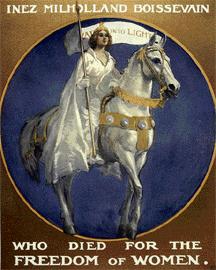 |
| Inez with faceted-star helmet/crown, cape, Maltese cross. What is this? Photo by Rudolf Eickemeyer, Jr., c. 1911. Library of Congress. |
It's worth exploring what she wore on a mounted leadership of the 1911 New York City parade, i.e., a helmet-like crown topped by a star, and a cape with a black Maltese cross on the left arm.
No one ever seems to have commented on these two symbols. Where did they come from?
- The faceted star...
- The Maltese Cross...
The faceted star or mullet in heraldry signifies divinity. The helmet-crown is actually much like the hinged visor that comes down to cover the mouth.
The overall effect is Joan of Arc, although we are told that Joan was a cross-dresser–both because it was easier to be a warrior in a man's clothes and because it made her less vulnerable to male sexual predation. Inez below the neck has lost the Joan of Arc warrior look, at least from the front. That's not a man's fighting costume.
The Maltese Cross
The Maltese Cross is associated with the Knights of Malta (previously of Rhodes), who were founded to care for and also protect pilgrims visiting newly conquered Jerusalem after the First Crusade. The message is that Inez is on a crusade for women, to care for and protect them.
During the American Civil War, the Maltese Cross was used as a symbol for rescue workers. It has become a favorite design for fire department shields across the United States, including the FDNY, and also in other English-speaking countries.
While the 1911 cape that Inez wore shows a black Maltese cross on a white cape, the Maltese cross she wore at the head of the 1913 parade in Washington was described in The New York Times on March 3, 1913 as gold on pale blue. In heraldry there is only one blue (azure) and it is not pale, so the color of the cape appears to be influenced by aesthetic preferences rather than informed by heraldic scholarship.

No comments:
Post a Comment